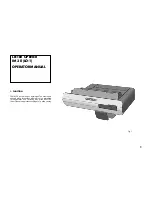
Page 2
MAINTENANCE
It is recommended that this cylinder be completely
disassembled approximately every five years for clean-
ing, inspection, and replacement of all rubber parts. The
first examination on this particular application will deter-
mine if the period between service should be extended
or shortened.
DISASSEMBLY
– Use care not to destroy or scratch
any parts during this procedure.
1. Remove the rod eye (15) from the piston rod (13).
2. With the cylinder lying horizontal on the floor, re-
move the four tie bolts (18) on the head end.
3. Remove the tie bolts.
4. Using a mallet, tap the cap (1) away from the tube
(2) and remove the tube seal “O” ring (11).
5. Hold the end of the piston rod (13) and using the
mallet, tap the head (3) carefully away from the tube
(2) just far enough to allow your hand to reach be-
tween the head and tube to grab and support the
piston rod. Now continue to tap the head off of the
rod.
6. Pull the piston rod upright to a vertical position and
then pull the tube (2) off of the piston rod assembly.
7. Clamp the piston rod in a vise, protecting the rod’s
surface, and remove the piston (14) from the piston
rod (13) by unscrewing nut and sliding the piston off
of the rod.
8. Remove the piston “O” ring (12), and two piston
seals (10).
9. Remove from the head (3) the tube seal “O” ring
(11), the rod wiper (8) and the rod seal (9).
CLEANING & INSPECTION
1. Clean all metal parts with a non-flammable solvent
and wash all elastomer or rubber parts with soap
and water. Rinse everything thoroughly and blow
them dry with a low pressure air jet.
2. Inspect all parts and throw away all those that are to
be replaced due to damage, wear or age. Give par-
ticular attention to the recommended replacement
parts as indicated on the parts list.
REASSEMBLY
– Use the exploded view as a guide
and lubricate all seals and grooves with Shell Oil Com-
pany’s Aeroshell Grease 14.
1. Assemble the rod seal (9) into the head (3), making
sure the concave side of the seal faces the inside of
the cylinder.
2. Install the rod wiper (8) in the head (3) with the
sharp edge facing the outside.
3. Clamp the piston rod (13) in a vise, install the piston
“O” ring (12) and slide the piston (14) onto the rod.
Fasten the piston into place using a torque wrench
and tighten to 500 ft-lbs using Loctite 277.
4. Install piston seals (10) onto the piston (14) with the
flat side of the seals facing the inside of the piston.
5. Set the piston rod assembly on end, protecting the
rod’s surface. Slide the head (3) down over the pis-
ton rod (13) being careful not to cut or damage the
wiper (8) or rod seal (9).
6. Lay the piston rod over towards its side and push it
through the head until the piston is about four inches
from the head.
7. Set the tube (2) on end and wipe some grease on
the inside at the very top.
8. Insert the tube seal “O” rings (11) into the head (3)
and the cap (1).
9. Fit the greased end of the tube on to the piston.
Carefully run a screwdriver around the first seal to
assist the entry into the tube. Push the tube forward
until it enters the groove in the head (3).
10. Slide the tie bolts (18) through the holes in the head.
11. Install the cap (1) onto the tube and slide the tie
bolts up to the threaded holes in the cap.
12. Using a torque wrench, tighten the nuts (19) onto
the tie rods (18) alternately on opposite sides to 70 ft
-lbs. DO NOT tighten one side first.
13. Torque rod eye (15) onto the piston rod (13) to 700
ft-lbs using Loctite 277 until it shoulders.
14. The reassembly is complete, therefore test the cylin-
der for correct operation and any evidence of leak-
age. DO NOT exceed 150 PSIG air pressure.























